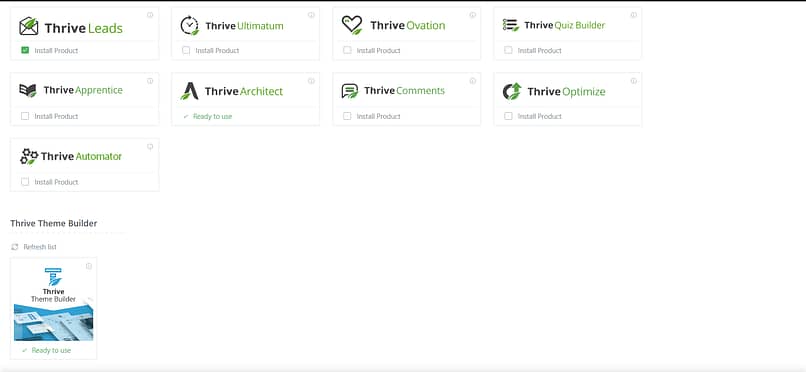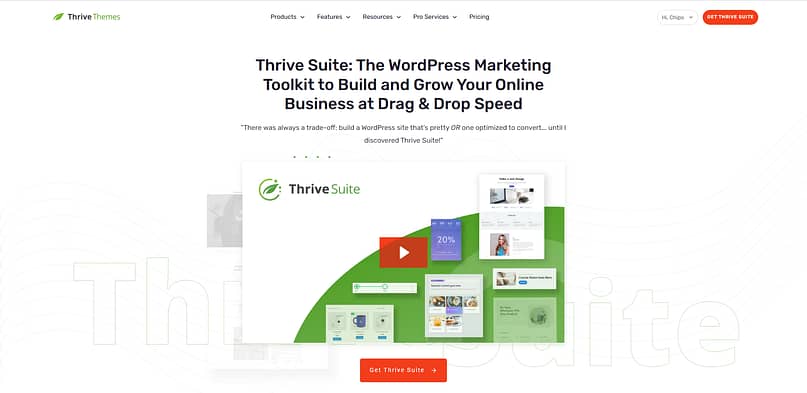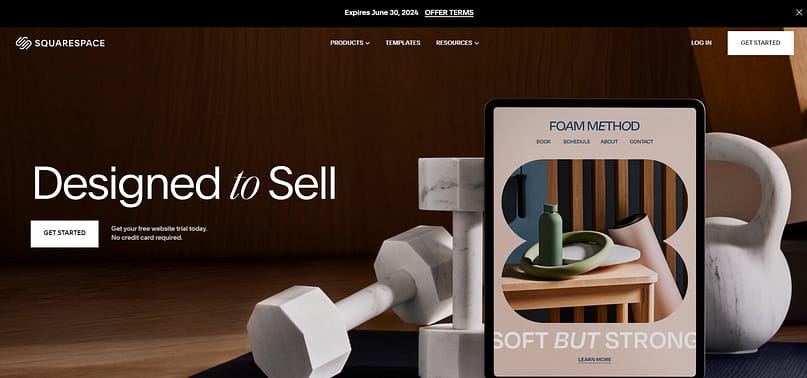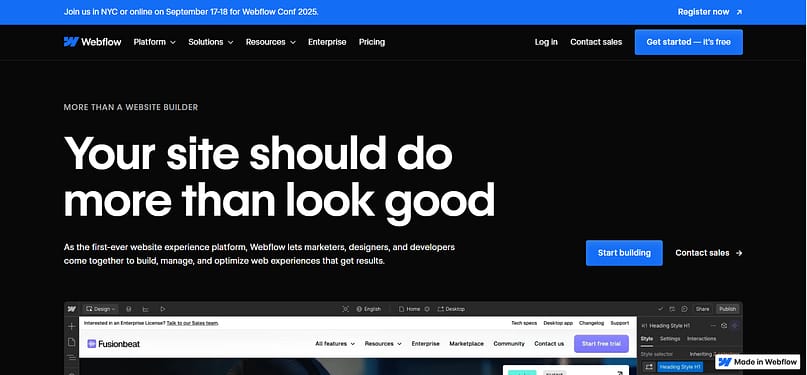Need a fast answer? Here’s what I recommend based on your goals:
Your Goal | Best Website Software |
|---|---|
Grow your list, sell courses, build funnels | WordPress + Thrive Suite |
Launch fast with minimal setup | Hostinger Website Builder or Durable |
Build a polished portfolio | Squarespace or Webflow |
Sell physical products | Shopify (or WooCommerce for more control) |
Design-heavy or content-rich site | Webflow or WordPress |
💡 Quick tip: If you're building for growth — not just speed — WordPress + Thrive Suite is the combo I always come back to.
But don't stop here.
This guide breaks down the real differences between platforms, the traps to avoid, and how to pick the right tool for where your business is going — not just where it is now.
👉 Keep scrolling and make a confident, future-proof choice.
Every week you spend debating "the best software to make a website" is a week you're not building your list, booking clients, or making sales.
Ask me how I know. (Spoiler: been there, regretted that.)
I’m not saying this to add to the pressure you’re probably already feeling – but I’m not going to lie to you.
It’s very easy to get trapped in decision mode for so long…you end up discarding that idea. And we don’t want that here.
So, take my hand friend and let me guide you through this no-BS, super clear guide on what website building options you should be looking at. I also mention my personal tech stack that’s helped me in the last years, which I feel would be a great fit for you, too.
Ready to get out of research mode and get several steps closer to seeing results?
Let’s dive in.
Why Trust This Guide?
I’ve been working with websites for over seven years. I'm talking writing about them, building them, breaking them (oops), launching them for clients, and optimizing them for sales, SEO, and lead generation.
Along the way, I’ve tried nearly every website builder, CMS, plugin, and “all-in-one” solution out there. I’ve also worked directly with business owners, freelancers, creators, and course builders who needed a site that needed to provide results.
So everything in this guide is based on first-hand experience, not just feature lists or sales pages.
I’ll show you what’s easy to start with, what scales well over time, and which options will quietly hold you back.
The Mistake I Made (And How It Almost Killed My Website Before It Started)
When I made the jump from “done-for-you” website solutions to actually trying to build a site on my own, I heavily underestimated the process.
I chose WordPress (I’ll go into that later) and thought, “oh let me get one of those pre-built themes from a store and load it immediately”. The demos looked great, but when I tried to load it on my platform? Disaster.
$120 wasted and it took forever to clean up that mess. Worst of all? No traction to my site. No leads, no sales, nothing.
And I was left trying to figure out how to move on from that.

You see, my mistake was thinking, “Oo, I just need something quick and pretty to get started and I’m set.” Boy was I wrong.
“A good-looking site” is just the start, but it doesn’t automatically bring in leads, clients, or sales.
It took me a few painful lessons to realize my perception affected my software choices. Because I thought aesthetics were the main priority, and “ease”, I chose the wrong website building software from the get-go and ended up working myself underground.
I don’t want you to be like me.
💰 I know you’re here because you’re trying to:
And to get to that goal, you’ll need to be strategic from Step 0. You aren’t just looking to build a “nice looking” site.
You need to pick website creation tools to create a site that:
Helps visitors take the next step
Loads fast and work on mobile
Is easy for you to update
Grows with your business, and doesn’t box you in
Otherwise, you’re not picking the right website platform to support your business goals, – you're just building a really expensive online brochure.
My Selection Process: How I Chose the Best Website Software for You
At this point, you know building a site that just looks good isn’t enough.It has to work for you, your audience, and the goals you’re actually chasing.
When I put this list of the best software to make a website together, I looked beyond whatever was trendy or easy.

You’ve probably done that already and remember – we’re not wasting time here.Instead, I looked for website building software that could actually support you long-term. To do this, I asked the right questions to find this list of options:
Can I get up and running without needing to search 1000 different tutorials and ask 20 questions in 7 different Reddit subthreads?
Will this platform grow with me when my business, content, or audience expands?
Does it have real marketing and lead generation tools, or will I end up duct-taping extra apps together six months from now?
Is it built to help me build a website for my business, not just create a portfolio that quietly collects dust?
Every option on this list passed those tests and a few more.
Because at the end of the day, there are website creation tools that quietly hold you back, and tools that quietly push you forward. If you’re here, you deserve the second kind.
Let’s Break it Down: What "Website Software" Actually Means (And Why It’s So Confusing)
Now, if you’ve been Googling “best software to make a website,” you’ve probably noticed something... weird.
Some sites talk about drag and drop builders.Some talk about WordPress.Some throw AI into the mix like it’s the future of everything.
It’s no wonder it feels like you’re comparing apples, oranges, and spaceships.
The truth is, "website software" is a huge, messy, all-encompassing term.It covers everything from quick DIY builders to full content management systems (CMS) to AI-powered site generators — and nobody really explains the difference.
So before I show you which specific tools I recommend, let’s slow down for a second and break this all down clearly:
💻 Website Builders (Wix, Squarespace, Weebly)
These are your classic drag and drop website builders — made for beginners who just want to get a site online quickly without touching any code.
✅ Good if you want a site up quickly
✅ Great for portfolios, simple service businesses, or testing an idea
❌ Not ideal if you want full control over marketing funnels, SEO, or conversion optimization later
❌ You may hit frustrating limits the second you want to customize anything serious
Bottom line: Perfect for existing online — not always perfect for growing online.
⚙️ CMS Platforms (WordPress.org)
When you hear "CMS," it basically means you’re getting way more control over your content, structure, and strategy – instead of being boxed into someone else's template.
WordPress is the heavyweight champion here — it’s the best website platform for people who want the freedom to really scale their business over time. Over 40% of websites are powered by WordPress – and that’s a big deal. For reference, other popular platforms power way less (Wix only powers 1.5% of websites and Squarespace powers less than 10%)
✅ You own everything — your content, your design, your domain
✅ You can add almost anything you want: membership sites, courses, booking systems, SEO tools
✅ You can evolve your site as your business grows
🔧 It does need hosting and a bit of setup — but it’s totally worth it if you’re playing the long game (and you can learn more about that here)
And if you’re worried about needing to code everything manually, don’t be.
There are tons of visual, drag-and-drop builders made for WordPress that let you design beautiful pages without touching a single line of code.
You get the best of both worlds: creative freedom and an easy-to-use interface.
💡 Real-world tip: WordPress is amazing, but setting everything up from scratch? Can be a biiiit of a drag. I shortcut the headache with Thrive Suite — it gives me landing pages, lead forms, quizzes, and even courses without needing a full-blown tech team. (We’ll dive into that combo a little later.)
🤖 AI Website Builders (Wix ADI, Hostinger, Durable)
AI website builders are the new kids on the block — and honestly, they’re not bad for certain situations.
These tools build full websites for you automatically — you answer a few questions, and boom, instant site.
Wix ADI — answers a few questions and designs a layout + copy for you
Hostinger Website Builder — super fast AI setup with SEO and conversion tools built in
Durable — one of the fastest full-stack setups (site + CRM + basic marketing) in minutes
✅ Great for quick launches, Minimum viable products (MVPs), side hustles
❌ Not ideal if you need full creative control or serious long-term scaling
If you need something live by this weekend, they’re amazing. If you’re planning to scale into a full business engine, they’ll start to feel limiting pretty fast.
🔥 So, what’s the real difference?
If you just want to exist online, a website builder will do the job.
If you want to grow something real — like an audience, a client base, or a course empire — WordPress + the right tools will get you a lot farther, a lot faster.
➡ ️ Now that you know what all these categories really mean, let’s talk about the specific tools I’d actually recommend — and the real talk on why.
The Best Software to Make a Website: Quick Picks and In-Depth Reviews
Alright, now that you know what actually matters when you’re building a website that grows your business, let’s get into the good stuff.
First, I’ll give you a quick-glance overview — so if you’re the type who just wants the "tell me what to use" version, you’re covered. Then we’ll dive deeper into the full reviews, where I’ll share what each platform is great at, where it might trip you up, and who it’s actually a good fit for (because not every tool fits every plan).
If you’ve ever felt paralyzed by too many choices, don’t worry — you’re about to leave this page knowing exactly what direction makes the most sense for you.
Quick-Glance: Best Website Software Based on What You’re Building
If you’re still wondering "ok, but which one’s actually right for me?" — here’s the quick and dirty version.
(Bookmark this part if you need to come back after the coffee kicks in.)
Your Goal | Best Website Software | Why It Works |
|---|---|---|
Blogging or Content Marketing | WordPress + Thrive Architect | Total control over design, SEO, and lead generation. Built to grow. |
Selling a Service (Coaching, Consulting, Freelancing) | WordPress + Thrive Suite + a simple booking plugin | Helps you build trust, capture leads, and book clients without endless email chains. |
Building a Portfolio | Fast, polished, mobile-friendly, and easy to update. | |
Selling an Online Course or Membership | WordPress + Thrive Apprentice | Own your platform, keep your profits, no course platform fees draining you monthly. |
Selling Physical Products | Shopify or WooCommerce (WordPress) | Shopify = simple and fast, WooCommerce = full control and better profit margins if you’re willing to get a little nerdy. |
Launching a Side Hustle or MVP | AI-powered site builders that get you online fast with minimal effort (but not forever platforms). |
Real Software That Gets Real Results (And My Two Cents on Each)
You’ve seen the quick comparison, but I want to slow it down for a second and talk about these options like I would if we were sitting across from each other. Here's what I really think about the tools on this list — no hype, just honest observations.
Best For:
Building high-converting websites, funnels, online courses, and long-term business growth with full control.
I tried a lot of platforms (probably every single one on this list) before I gave WordPress.org a try – and I’ve been there ever since.
I’ll admit that the whole “self-hosting” thing put me off for years, because even though I’d been in the blogging and website space for a while, I assumed that self-hosted WordPress was too technical for me – but I was wrong.
Are there a few extra steps compared to using a hosted platform like Wix or Squarespace? Yes, but these steps, in my opinion, are worth it because they lead to you having total control over your website. It’s the platform that powers 40% of the internet for a reason.
That ownership? It matters more than you think.
On closed platforms, you’re always playing by someone else’s rules — higher fees as you grow, random policy changes (like blocking paid ads or email marketing), limited design freedom, and a painful migration process if you ever want to leave.
With WordPress, you own it all — your growth, your strategy, your future.No surprise limits. No begging for flexibility. No getting boxed in when you’re ready to level up.You get a website you can actually grow with — not just now, but three, five, ten years from now.
Here’s why I recommend it:
Full ownership — your domain, your content, your business
Room to scale — from a simple blog to full-blown memberships, stores, and courses
Real SEO power — WordPress makes it way easier to get found on Google (trust me, this matters)
Now, WordPress is only as good as the tools you build it with.
You can build a full site using just WordPress’s native tools — like the Block Editor and Full Site Editing (FSE).But for most people, especially if you care about conversions or customization, the built-in options feel clunky and limiting pretty fast.
That’s why the tools you stack with WordPress matter — they’re what turn it from "basic website" into "growth engine."
My choice?
Thrive Suite — it gives you everything you actually need to sell, not just exist. I’m talking drag-and-drop landing pages, high-converting lead forms, online quizzes that actually grow your list, beautiful sales pages, full online course builders – all built to work together without duct-taping random plugins.
💬 WordPress gave me freedom. Thrive Suite gave me momentum. If I could start over, I’d skip the experiments and just build here from day one.
👉 Want to see how Thrive Suite fits into a WordPress setup? [Learn more here.]
Best For:
Small service businesses, personal brands, and portfolios that need a fast, code-free launch.
Wix comes with a lot of hype and I can see why. It’s super easy to get started and you can have a decent-looking website by the end of a day.
It’s one of the easiest ways to get something online without needing a tech manual. You choose a template, drag and drop your way around, and boom — you’re live.
I usually recommend Wix for small service businesses, portfolios, or early-stage projects where momentum matters more than customization.
Here’s why it works:
Quick, easy setup — you can build a full site in a single afternoon
Lots of templates — especially for creative businesses, personal brands, and portfolios
Built-in basic tools — blogging, simple stores, and online bookings without needing extra apps
But there are a few things to watch out for:
Template lock-in — once you choose a design, you’re stuck unless you rebuild from scratch
Migration headaches — from personal experience from migrating an old site from Wix to WordPress, migrating isn’t easy or clean
Limited scalability — it’s great for getting started, but you might feel boxed in if your marketing or tech needs grow
💬 Wix is amazing for smaller projects where speed and simplicity win. But if you’re building something you plan to scale seriously over time, it’s worth thinking bigger from the start.
Best For:
Design-focused creators, photographers, and service providers who want a polished, professional site with minimal setup.
I see Squarespace as the “artsy” one of the group. You know, that cool kid in the corner who wears all black and has that air about them? Yeah, Squarespace.
If you want a beautiful website without agonizing over design decisions, Squarespace is hard to beat.It’s clean, polished, and feels almost like cheating — in a good way. You pick a stunning template, tweak a few settings, and it’s ready to go live.
I usually recommend Squarespace for creative businesses (artists, musicians, etc.), service providers, and anyone who cares more about looking professional than endlessly customizing every button and widget.
Here’s why it works:
Beautiful templates — modern, minimalist designs that make your brand look polished from day one
All-in-one setup — hosting, templates, blog, basic store, all in one package
Built-in marketing basics — email marketing, simple SEO settings, and easy social integrations (but these are available on their more expensive plans)
But heads up:
Limited customization — if you want to heavily tweak layouts or add advanced functionality, you might hit walls fast
Scaling can get tricky — it’s great for a clean starter site, but if you want deep marketing funnels, memberships, or custom workflows, it starts feeling boxed in
Template similarities — a lot of Squarespace sites tend to "look the same" if you don’t put in extra effort
💬 Squarespace is perfect when you want something that looks beautiful without a battle. But if you’re the type who likes to tinker, tweak, and grow beyond a clean portfolio, you might feel its limits sooner than you'd like.
Best For:
Designers, visual brands, and advanced users who want pixel-perfect control without relying on code.
Webflow is like giving a designer their dream playground — total creative freedom, no coding (if you don't want it), and pixel-level control over every part of your site.It’s seriously powerful, but it’s not for the faint of heart. If the words “flexbox” or “CSS grid” make you break out in hives, there’s going to be a learning curve.
I usually recommend Webflow for designers, design-driven brands, and business owners who really want full visual control — and don’t mind spending time learning the ropes.
Here’s why it works:
Full creative control — you can literally build almost anything visually, without coding
Built-in CMS — perfect for blogs, dynamic portfolios, or content-heavy sites
Hosting included — fast, secure hosting without needing a separate plan
But it’s not without its quirks:
Steep learning curve — Webflow is way easier than coding from scratch, but it’s still a commitment
Pricing adds up — especially if you need CMS hosting, e-commerce, or advanced features
Not ideal for beginners — if you just want “drag, drop, done,” Webflow will feel like overkill
💬 Webflow is amazing if design is your priority and you love tinkering. But if you’re mostly thinking “I just want a site that works and sells stuff,” there are easier paths.
Best For:
Product-based businesses that want to launch and manage an online store quickly without cobbling together tools.
If you’re selling physical products and want an online store that just works without needing to piece everything together yourself, Shopify is one of the best bets out there. It’s built from the ground up for eCommerce — inventory, payments, shipping, customer accounts, all ready to roll.
I usually recommend Shopify for larger businesses that want to hit the ground running with sales, not spend six months DIY-ing a storefront.
Here’s why it works:
Made for selling — Shopify handles products, orders, payments, and taxes without needing a million plugins
Built-in reliability — secure hosting, fast load times, and strong uptime out of the box
App store options — tons of apps for marketing, shipping, and customization (but see below...)
But here’s the stuff they don’t always tell you:
Monthly fees stack up — especially once you start adding apps, payment gateways, or premium themes
Limited deep customization — you can make it look good, but building super custom workflows often means hiring a developer (or wrestling with Liquid code)
Hard to move away from — once you’re in Shopify’s ecosystem, it’s a lot of work to migrate elsewhere later
💬 Shopify is like moving into a fully furnished apartment — super convenient, super fast, but if you want to knock down walls later, it gets complicated. Amazing if you’re running a real product business. Less amazing if you’re trying to hack it into something it’s not built for.
AI Website Builders (Hostinger & Durable)
Best For:
Beginners, budget-conscious users, and quick MVPs or service sites that need to go live fast.
If you’re thinking, "I just need a decent website live by tomorrow," AI website builders have honestly gotten quite good.They’re not perfect, and they’re not built for scaling into a six-figure empire — but if you need to move fast and look professional, they’re a lifesaver.
I recommend AI builders like Hostinger and Durable for quick launches, side hustles, MVPs, and service sites where done is way better than perfect.
Here’s why they work:
Ridiculously fast setup — you answer a few questions, and the AI designs your site layout, writes your copy, and drops in images
Built-in tools — basic SEO, basic marketing features, basic e-commerce if you need it
No tech skills needed — you’re more or less skipping the “learn WordPress” or “customize a theme” phase completely
But (and it’s a big but):
Customization is limited — if you want pixel-perfect design or deep integrations, you’ll feel boxed in
Not built for heavy scaling — great for starting... not great for building complex funnels, memberships, or big stores
Ownership is blurry — depending on the platform, migrating away later might not be easy
💬 AI builders are incredible if you just need to launch something fast. But if you already know you want a long-term, highly customized business site? I'd still reach for WordPress (with the right stack) instead.
Bottom line: Pick based on where you want to be six months from now, not just what feels easiest today. There’s no “perfect” choice — just the one that gets you moving toward your goals faster.
What Most Reviews Don’t Tell You (That Kills Your Results)
Most website software reviews talk about pretty templates and easy editors like that’s all that matters.
But when you’re actually trying to grow a business — not just decorate a homepage — here’s what really wrecks your results:
🚫 No clear call-to-action — Visitors land on your site, think “looks nice,” and then... leave. No clicks, no signups, no sales.
🚫 Slow mobile sites — More than half of your traffic is probably on their phone. If your site drags? They’re bouncing before you can say "wait!"
🚫 No built-in lead generation — If you can’t collect emails or build a list easily, you’re basically rebuilding your audience from scratch every time you want to launch something.
🚫 Weak SEO foundations — Pretty doesn’t help if nobody finds you. Bad SEO setups quietly strangle your site’s growth before it even gets going.
A beautiful site is fun. But a beautiful site that moves people to act — to sign up, to buy, to book you — is what actually grows your business.
💬 That’s why when I recommend website software, I’m not just thinking "ooh, nice design." I'm thinking: "Can this site turn a visitor into a real client, subscriber, or customer?"
The WordPress Stack (with Thrive Suite): What I Use for Every High-Converting Site
There’s a reason I don’t recommend random website builders once you’re serious about growth.
WordPress gives you freedom.Thrive Suite gives you the tools to turn that freedom into conversions, sales, and momentum.
This is the stack I use, and honestly, I’d have saved myself a lot of time (and forehead wrinkles) if I’d started here.
Why WordPress?
✅ You own everything — your content, your domain, your design.
✅ You can build anything — blogs, sales funnels, online courses, full-blown businesses.
✅ You’re not stuck paying higher and higher monthly fees as you grow.
It’s flexible, powerful, and ready for whatever your next move looks like.
Why I Add Thrive Suite
WordPress is amazing, but out of the box? It’s basically an empty house. You still need furniture, electricity, maybe some good coffee and Wi-Fi.

Thrive Suite Plugins
That’s what Thrive Suite gives you:
🧱 Thrive Architect — Drag and drop landing pages built to actually get clicks and signups, not just look pretty.
📩 Thrive Leads — Opt-in forms, popups, and smart targeting to grow your email list.
🎓 Thrive Apprentice — Create and sell your online courses without coughing up a percentage of your income to some platform.
🧠 Thrive Quiz Builder — Build fun, targeted quizzes that segment your audience and boost engagement (hello, higher conversions).
🌟 Thrive Ovation — Automatically collect and showcase testimonials without the awkward follow-up emails.
🔥 Thrive Ultimatum — Add real FOMO with evergreen countdown timers and scarcity campaigns that actually drive action.
Together, they turn WordPress from "nice website" into a real business machine — ready to attract, engage, and convert visitors without needing 57 different plugins duct-taped together.
Personal note: I’ve used other setups — piecing together different plugins, crossing my fingers that updates wouldn’t break everything. It was fine when I didn’t know better. But once I switched to WordPress + Thrive Suite, everything got simpler, faster, and honestly? Way more fun.
If you’re building a website for your business, not just for show, this is the setup I’d recommend every single time.
What You’ll Pay (And What You’re Actually Getting)
Let’s talk money.
Because yes, the software you choose will cost something — whether it’s upfront or sneaking up on you later with "upgrade for this feature" messages.
Here’s a real-world look at what you’re actually signing up for:
Tool | Monthly Cost (Approx.) | Best For |
|---|---|---|
WordPress + Thrive Suite | From $25–30/mo (hosting + Thrive) | Full control, high-converting sites, funnels, and online courses |
Wix | From $17–35/mo | Fast setup for service-based businesses and simple stores |
Squarespace | From $16–49/mo | Portfolios, service providers, content creators |
Shopify | From $29+/mo | Product-based businesses (physical eCommerce) |
Hostinger Website Builder | From $3–5/mo | Budget-friendly quick launch (great for beginners) |
Durable | From $12+/mo | Fastest AI-powered site for freelancers and tiny businesses |
A few things they don't always tell you:
Free plans usually come with ads, ugly domain names, and heavy limitations. Great for practice, not great for building trust.
Starter plans often hide the real cost — once you add payments, SEO tools, or better templates, the price jumps.
Owning your setup (like WordPress + Thrive) costs a little more upfront, but saves you so much frustration and upgrade fees later.
In short?
You can either rent a basic site month-to-month, or you can build an asset you actually own and grow.
Guess which one feels better a year from now.
Mindset Shift: Your Website Is a Funnel, Not a Flyer
One of the pivotal moments in my career, the thing that eventually pulled me deep into marketing, was realizing that just having a website isn’t enough.
For a long time, I thought if I just picked a nice template, wrote some friendly copy, and hit publish, the magic would happen. Spoiler: it didn’t.
It wasn’t until I started learning about funnels that everything clicked.
👉 A website isn't just there to "look professional" or “show you exist.”
👉 It’s there to move people forward — step by step — toward buying, booking, signing up, or working with you.

Here’s how I started looking at websites differently:
Homepage: Not just a pretty welcome mat. → It should guide visitors toward taking real action — signing up, buying, booking — not just “exploring.”
Service pages: Not a long list of what you offer. → They should answer the visitor’s “why should I care?” and make the next step ridiculously obvious.
Blog posts: Not just free content for the sake of content. → Every post should offer a next step: an email signup, a related product, a discovery call, something.
Landing pages: Not a gallery of your design skills. → They should have one job: conversion, not confusion.
Here’s a little gut check I still use before publishing any page: 🧠 "If someone lands here, do they instantly know what to do next?" If the answer is anything but "yes," the page needs more clarity.
💬 Learning this changed everything for me — and it’s why I look at website software through a very different lens now.
Not just 'Is it pretty?'
But 'Can it actually help someone build a real funnel that grows their business?'
Final Thoughts: How to Actually Choose the Best Software to Make a Website That Grows With You
If there’s one thing I hope you take away from all this, it’s that your website isn’t just a project to check off your to-do list. It’s the engine that powers your growth — if you set it up right.
You don’t need the flashiest templates. You don’t need the trendiest drag-and-drop builder.
You need software that matches where you’re going next. Something that doesn’t just help you build a website... but helps you build momentum, community, income — whatever you’re chasing.
If you’re serious about growing your business online, WordPress + Thrive Suite is the stack I’d hand you every time.
It’s what I use. It’s what I trust. And it’s what I wish I’d started with sooner.
If you’re just testing an idea? AI website builders like Hostinger or Durable are amazing for getting your feet wet.
But whatever you choose — pick something that serves you now and still has your back six months, one year, three years down the line.
🎯 Want to see how Thrive Suite can turn your WordPress site into a lead-generating, course-launching, funnel-building machine? Take a look here
You've got this. And now you know how to build it the smart way.








